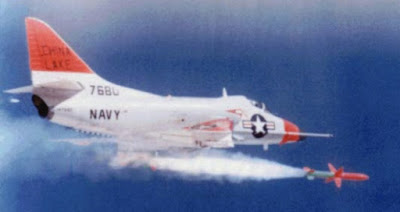Ensign Raymond Maxwell Hite, Jr was killed on 18 May 1961 in
the crash of the first Sageburner attempt to set the record for “speed over a straight three-kilometer course at a
restricted altitude” with the McDonnell F4H Phantom II. This involved making four passes, two in each direction,
at an altitude above the ground of no more than 100 meters (328 feet). Hite was the Radar Intercept Officer in the rear cockpit.
Most accounts of the accident (including, I regret to
report, my own) only mention the pilot, Commander Jack L. Felsman. At some
point early on, Hite’s presence began to be overlooked, which is lamentable
because he was the epitome of Tom Brokaw’s “Greatest Generation” and arguably
critical to the success of the record-breaking attempt because of his ability
to use the F4H’s radar to coach the pilot onto the course, not easily seen
visually from an altitude of only 100 feet at supersonic speed.
In 1942, when he was only 14 but big and mature for his years,
he enlisted in the Army Air Corps. Before his true age was discovered and he
was discharged, he had flown combat missions as a gunner in a Martin B-26 and
shot down a German fighter. At 17, he joined the Navy, initially serving as a
gunner on a patrol bomber.
In 1952, he was selected for training as an enlisted Bombardier/Navigator.
This was not unusual at the time but becoming rare. It had been a natural
transition of enlisted men from gunners/radiomen to radar operators to
bombardiers. However, by the late 1950s, following the introduction of the
Douglas A3D Skywarrior, almost all Navy bombardier/navigators were officers.
As reported in one of his commendations, he won the top individual
honors by a wide margin in Heavy Attack Wing One’s Sixth Bombing Derby held in
December 1958: “The competition tested performance in bombing, celestial and
radar navigation, and a thorough understanding of special weapons in addition
to normal crew duties and understanding of aircraft systems.”
In part as a result, Hite was selected to be an officer and
commissioned as an Ensign in January 1960. His new assignment as a Limited Duty
Officer, Aviation Ordnance, was to be part of the A3J-1 Vigilante test program
as bombardier/navigator. His new duty station was the U.S. Naval Air Special
Weapons Facility at Kirtland Air Force Base, Albuquerque, New Mexico.
Hite had already survived two horrific Navy carrier-based
bomber accidents, bailing out of an AJ Savage that had lost its vertical fin
and an A3D Skywarrior after an explosion severed its aft fuselage. Unfortunately, he and
Felsman had no chance to escape this one. The Navy investigation attributed the crash to an unsuspected pitch-damper failure, the slowness of the existing pitch-trim system, Felsman's abrupt last-moment maneuver to line up on the record course, and the susceptibility of the F4H to Pilot-Induced Oscillation (PIO) at transonic speed and low altitude. PIO occurs when the airplane’s dynamic response to an externally
generated (e.g. turbulence) pitch change matches that of the pilot’s response
to it. If both airplane and pilot then react, again simultaneously, to the larger
than expected pitch change, hell’s-own roller-coaster ride results. If the pilot
doesn’t take himself out of the loop, i.e. let go of or not move the stick, the
result could be an overload of the airplane’s structure.
When I joined McDonnell in 1966 as a flight test engineer
fresh out of college, I was shown the then closely held movie clip of the
inflight breakup of the first Sageburner. The pitch excursions didn’t seem
particularly large but within a few seconds and about three cycles, ended with
the airplane disintegrating at 14 gs, well above its design structural limit, and the
engines flying out of the debris headed down course. It is now a video on YouTube.
Raymond Hite left a pregnant wife and three daughters bereft
that day. He deserves to be remembered for the moment that ended his almost 20
years of service to his country.











